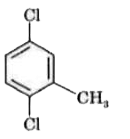Give the IUPAC names of the following compounds:
(i) CH3CH(Cl)CH(Br)CH3
(ii) CHF2CBrClF
(iii) ClCH2C≡CCH2Br
(iv) (CCl3)CCl
(v) CH3C(pClC6H4)2CH(Br)CH3
(vi) (CH3)3CCH=C(Cl)C6H4I−p
To provide the IUPAC names for the given compounds, we will follow a systematic approach for each one. Below are the step-by-step solutions:
1. Identify the longest carbon chain: The longest chain has 4 carbon atoms (butane).
2. Identify substituents: There are two substituents: Cl (chlorine) and Br (bromine).
3. Number the carbon chain: Numbering from left to right gives Cl at position 2 and Br at position 3.
4. Write the name: The substituents are named in alphabetical order. Thus, the name is 2-bromo-3-chlorobutane.
IUPAC Name: 2-bromo-3-chlorobutane
(ii) CHF₂CBrClF
1. Identify the longest carbon chain: The longest chain has 2 carbon atoms (ethane).
2. Identify substituents: The substituents are 1 bromine (Br), 1 chlorine (Cl), and 2 fluorines (F).
3. Number the carbon chain: Numbering from left to right gives Br at position 1, Cl at position 1, and F at positions 2 and 2.
4. Write the name: The name is 1-bromo-1-chloro-2,2-difluoroethane.
IUPAC Name: 1-bromo-1-chloro-2,2-difluoroethane
(iii) ClCH₂C≡CCH₂Br
1. Identify the longest carbon chain: The longest chain has 4 carbon atoms (butyne).
2. Identify substituents: There are Cl (chlorine) and Br (bromine) substituents.
3. Number the carbon chain: Numbering from right to left gives Cl at position 1 and Br at position 4.
4. Write the name: The name is 1-chloro-4-bromobutyne.
IUPAC Name: 1-chloro-4-bromobutyne
(iv) (CCl₃)₂CCl
1. Identify the longest carbon chain: The longest chain has 3 carbon atoms (propane).
2. Identify substituents: There are two CCl₃ (trichloro) groups and one Cl (chlorine).
3. Number the carbon chain: Numbering gives Cl at position 1 and both CCl₃ at position 2.
4. Write the name: The name is 2,2,2-trichloro-1-chloropropane.
IUPAC Name: 2,2,2-trichloro-1-chloropropane
(v) CH₃C(pClC₆H₄)₂CH(Br)CH₃
1. Identify the longest carbon chain: The longest chain has 5 carbon atoms (pentane).
2. Identify substituents: There are two p-chlorophenyl (pClC₆H₄) groups and one Br (bromine).
3. Number the carbon chain: Numbering gives Br at position 3 and both pClC₆H₄ at position 2.
4. Write the name: The name is 3-bromo-2,2-bis(p-chlorophenyl)pentane.
IUPAC Name: 3-bromo-2,2-bis(p-chlorophenyl)pentane
(vi) (CH₃)₃CCH=C(Cl)C₆H₄I-p
1. Identify the longest carbon chain: The longest chain has 5 carbon atoms (pentene).
2. Identify substituents: There are three methyl groups (from (CH₃)₃C), one Cl (chlorine), and one p-iodophenyl (C₆H₄I).
3. Number the carbon chain: Numbering gives Cl at position 3 and the p-iodophenyl at position 4.
4. Write the name: The name is 3-chloro-4-(p-iodophenyl)-2-methylpent-2-ene.
IUPAC Name: 3-chloro-4-(p-iodophenyl)-2-methylpent-2-ene
2. Identify substituents: There are two substituents: Cl (chlorine) and Br (bromine).
3. Number the carbon chain: Numbering from left to right gives Cl at position 2 and Br at position 3.
4. Write the name: The substituents are named in alphabetical order. Thus, the name is 2-bromo-3-chlorobutane.
2. Identify substituents: The substituents are 1 bromine (Br), 1 chlorine (Cl), and 2 fluorines (F).
3. Number the carbon chain: Numbering from left to right gives Br at position 1, Cl at position 1, and F at positions 2 and 2.
4. Write the name: The name is 1-bromo-1-chloro-2,2-difluoroethane.
2. Identify substituents: There are Cl (chlorine) and Br (bromine) substituents.
3. Number the carbon chain: Numbering from right to left gives Cl at position 1 and Br at position 4.
4. Write the name: The name is 1-chloro-4-bromobutyne.
2. Identify substituents: There are two CCl₃ (trichloro) groups and one Cl (chlorine).
3. Number the carbon chain: Numbering gives Cl at position 1 and both CCl₃ at position 2.
4. Write the name: The name is 2,2,2-trichloro-1-chloropropane.
2. Identify substituents: There are two p-chlorophenyl (pClC₆H₄) groups and one Br (bromine).
3. Number the carbon chain: Numbering gives Br at position 3 and both pClC₆H₄ at position 2.
4. Write the name: The name is 3-bromo-2,2-bis(p-chlorophenyl)pentane.
2. Identify substituents: There are three methyl groups (from (CH₃)₃C), one Cl (chlorine), and one p-iodophenyl (C₆H₄I).
3. Number the carbon chain: Numbering gives Cl at position 3 and the p-iodophenyl at position 4.
4. Write the name: The name is 3-chloro-4-(p-iodophenyl)-2-methylpent-2-ene.
Topper's Solved these Questions
- BOOK - PRADEEPCHAPTER - HALOALKANES AND HALOARENESEXERCISE - NCERT EXEMPLAR PROBLEMS WITH ANSWERS, HINTS AND SOLUTIONS (MULTIPLE CHOICE QUESTIONS-I)30videos
HALOALKANES AND HALOARENES
- BOOK - PRADEEPCHAPTER - HALOALKANES AND HALOARENESEXERCISE - NCERT EXEMPLAR PROBLEMS WITH ANSWERS, HINTS AND SOLUTIONS (MULTIPLE CHOICE QUESTIONS-II)11videos
HALOALKANES AND HALOARENES
- BOOK - PRADEEPCHAPTER - HALOALKANES AND HALOARENESEXERCISE - NCERT QUESTIONS AND EXERCISES WITH ANSWERS (NCERT INTEXT UNSOLVED QUESTIONS)9videos
HALOALKANES AND HALOARENES
- BOOK - PRADEEPCHAPTER - GENERAL PRINCIPLES AND PROCESSES OF ISOLATION OF ELEMENTS EXERCISE - Curiosity Questions2videos
GENERAL PRINCIPLES AND PROCESSES OF ISOLATION OF ELEMENTS
- BOOK - PRADEEPCHAPTER - ORGANIC COMPOUNDS CONTAINING NITROGENEXERCISE - IMPORTANT QUESTIONS FOR BOARD EXAMINATION27videos
ORGANIC COMPOUNDS CONTAINING NITROGEN
Similar Questions
Give the IUPAC names of the following compounds:
(i)CH3CH(Cl)CH(Br)CH3
(ii)CHF2CBrClF
(iii)ClCH2C≡CCH2Br
(iv)(CCl3)3CCl
(v)CH3C(p−ClC6H4)2CH(Br)CH3
(vi)(CH3)3CCH=CClC6H4I−pView SolutionGive the iUPAC names of the following compounds:
(i). CH3CH(Cl)CH(Br)CH3
(ii). CHF2CBrCIF
(iii). ClCH2C≡CCH2Br
(iv). (CCl3)3CCl
(v). CH3C(p−ClC6H4)2CH(Br)CH3
(vi). (CH3)3CCH=C(Cl)C6H4I−p.View Solution
Knowledge Check
- Question 1 - Select One
The IUPAC name of following compound is :−
Cl−CH2−C=C−CH3−Br.A1−Chloro−4−bromo but−2−yneB1−Bromo−4−chloro but−2−yneC4−Bromo−1−chloro but−2−yneD1−Bromomethyl−2−chloromethyl ethyne
Give the IUPAC names of the following compounds
(i) CH3CH(Cl)CH(Br)CH3 (ii) CHF2CBrClF
(iii) ClCH3C≡CCH2Br (iv) (CCl3)3CCl
(v) CH3C(p−ClC6H4)2CH(Br)CH3 (vi) (CH3)3CCH=C(Cl)C6H4I−pView SolutionGive the IUPAC names of the following compounds :
(i) CH3CH(Cl)CH(Br)CH3 (ii)CHF2CBrClF
(iii)ClCH2C≡CCH2Br (iv)(CCl3)3CCl
(v)CH3C(p−ClC6H4)2CH(Br)CH3 (vi)(CH3)3CCH=ClC6H4I−pView SolutionWrite IUPAC names of the following compounds :
(a) CH3CH(Cl)CH(Br)CH3
(b) CHF2CBrClF
(c) ClCH2C≡CCH2Br
(d) (CCl3)3CCl
(e) CH3C(p−ClC6H4)2CH(Br)CH3
(f) (CH3)3CCH=C(Cl)C6H4I−p
(g) CH3CHCl(CH2)2CCl2C2H5View SolutionGive the IUPAC names of the following compounds:
(i) CH3−C∣BrH−CH2−CH3
(ii)
(iii) CH2=CH−CH2−ClView SolutionGive the IUPAC name of the following compound.
CH2=C−C | CH3H2BrView SolutionWrite IUPAC names of the following compounds :
(i) CHF2CBrClF (ii) ClCH2C≡CCH2Br (iii) CH3CH=CH−CH3∣C∣Br−CH3
(iv) (CH3)2C=CHCH2Cl (v) (CH3)3CCH(Cl)CH(CHBrCH3)CH2CH2CH(CH3)2
(vi) (vii) CH3−CH3∣C∣CH3−ClView Solution
(vii) CH3−CH3∣C∣CH3−ClView SolutionWrite IUPAC names of the following compounds :
(i) CHF2CBrClF (ii) ClCH2C≡CCH2Br (iii) CH3CH=CH−CH3∣C∣Br−CH3
(iv) (CH3)2C=CHCH2Cl (v) (CH3)3CCH(Cl)CH(CHBrCH3)CH2CH2CH(CH3)2
(vi) (vii) CH3−CH3∣C∣CH3−ClView Solution
(vii) CH3−CH3∣C∣CH3−ClView Solution

